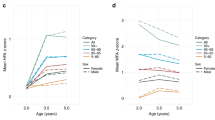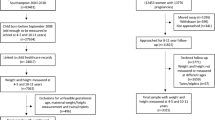Abstract
OBJECTIVE: To determine the degree of tracking of adiposity from childhood to early adulthood, and the risk of overweight in early adulthood associated with overweight in childhood and parental weight status in a cohort of children born in the mid-1970s.
DESIGN: Longitudinal observational study.
SUBJECTS: Approximately 155 healthy boys and girls born in Adelaide, South Australia, 1975–1976 and their parents.
MEASUREMENTS: Height and weight of subjects at 2 y, annually from 4 to 8 y, biennially from 11 to 15 y and at 20 y, and of parents when subjects were aged 8 y. Body mass index (BMI) of subjects converted to standard deviation scores and prevalence of overweight and obesity determined using worldwide definitions. Parents classified as overweight if BMI≥25 kg/m2. Tracking estimated as Pearson's correlation coefficient. Risk ratio used to describe the association between weight status at each age and parental weight status and weight status at 20 y and weight status at each earlier age, both unadjusted and adjusted for parental weight status.
RESULTS: The prevalence of overweight/obesity increased with age and was higher than that reported in international reference populations. Tracking of BMI was established from 6 y onwards to 20 y at r-values >0.6, suggesting that BMI from 6 y is a good indicator of later BMI. Tracking was stronger for shorter intervals and for those subjects with both parents overweight compared with those with only one or neither parent overweight. Weight status at an earlier age was a more important predictor of weight status at 20 y than parental weight status, and risk of overweight at 20 y increased further with increasing weight status of parents.
CONCLUSION: Strategies for prevention of overweight and targeted interventions for prevention of the progression of overweight to obesity are urgently required in school-aged children in order to stem the epidemic of overweight in the adult population.
This is a preview of subscription content, access via your institution
Access options
Subscribe to this journal
Receive 12 print issues and online access
$259.00 per year
only $21.58 per issue
Buy this article
- Purchase on Springer Link
- Instant access to full article PDF
Prices may be subject to local taxes which are calculated during checkout
Similar content being viewed by others
References
WHO. Obesity. Preventing and managing the global epidemic. Report of a WHO consultation on obesity. World Health Organization: Geneva; 1998.
Dietz WH . Health consequences of obesity in youth: childhood predictors of adult disease. Pediatrics 1998; 101: 518–525.
Power C, Lake JK, Cole TJ . Measurements and long-term health risks of child and adolescent fatness. Int J Obes Relat Metab Disord 1997; 21: 507–526.
Guo SS, Roche AF, Chumlea WC, Gardner JD, Siervogel RM . The predictive value of childhood body mass index values for overweight at age 35 y. Am J Clin Nutr 1994; 59: 810–819.
Power C, Lake JK, Cole TJ . Body mass index and height from childhood to adulthood in the 1958 British birth cohort. Am J Clin Nutr 1997; 66: 1094–1101.
Serdula MK, Ivery D, Coates RJ, Freedman DS, Williamson DF, Byers T . Do obese children become obese adults? A review of the literature. Prev Med 1993; 22: 167–177.
Lake JK, Power C, Cole TJ . Child to adult body mass index in the 1958 British birth cohort: associations with parental obesity. Arch Dis Child 1997; 77: 376–381.
Whitaker RC, Wright JA, Pape MS, Seidel KD, Dietz WH . Predicting obesity in young adulthood from childhood and parental obesity. N Engl J Med 1997; 337: 869–873.
Trudeau F, Shephard RJ, Arsenault F, Laurencelle L . Changes in adiposity and body mass index from late childhood to adult life in the Trois-Rivieres Study. Am J Hum Biol 2001; 13: 349–355.
Guillaume M, Lapidus L, Beckers F, Lambert A, Bjorntorp P . Familial trends of obesity through three generations: the Belgian-Luxembourg child study. Int J Obes Relat Metab Disord 1995; 19: S5–S9.
Burke V, Beilin LJ, Dunbar D . Family lifestyle and parental body mass index as predictors of body mass index in Australian children: a longitudinal study. Int J Obes Relat Metab Disord 2001; 25: 147–157.
Bellizzi MC, Dietz WH . Workshop on childhood obesity: summary of the discussion. Am J Clin Nutr 1999; 70: 173S–175S.
Cole TJ, Bellizzi MC, Flegal KM, Dietz WH . Establishing a standard definition for child overweight and obesity worldwide: international survey. BMJ 2000; 320: 1240–1243.
Magarey AM, Daniels LA, Boulton TJC . Prevalence of overweight and obesity in Australian children and adolescents. Assessment of 1985 and 1995 data against new standard worldwide definitions. Med J Aust 2001; 174: 561–564.
Magarey AM, Boulton TJC . Food intake during childhood: percentiles of food energy, macronutrient and selected micronutrients from infancy to eight years of age. Med J Aust 1987; 147: 124–127.
Magarey AM, Boulton TJC . The Adelaide Nutrition Study. 1. Food energy intake through adolescence: including an evaluation of under-recording, age and sex differences. Aust J Nutr Diet 1994; 51: 104–110.
Boulton TJC . Nutrition in childhood and its relationship to early somatic growth, body fat, blood pressure and physical fitness. Acta Paediatr Scand 1981; 284 (Suppl): 1–85.
Cole TJ, Freeman JV, Preece MA . Body mass index reference curves for the UK, 1990. Arch Dis Child 1995; 73: 25–29.
Chinn S, Rona RJ . Prevalence and trends in overweight and obesity in three cross sectional studies of British children, 1974–94. BMJ 2001; 322: 24–26.
Flegal KM, Ogden CL, Wei R, Kuczmarski RL, Johnson CL . Prevalence of overweight in US children: comparison of US growth charts from the Centers for Disease Control and Prevention with other reference values for body mass index. Am J Clin Nutr 2001; 73: 1086–1093.
Magarey AM, Daniels LA . Comparison of Australian and US data on overweight and obesity in children and adolescents. Med J Aust 2001; 175: 500–501.
McLennan W, Podger A . National nutrition survey nutrient intakes and physical measurements. Australian Goverment Publishing Service: Canberra; 1998.
Casey V, Dwyer JT, Coleman Ka, Valadian I . Body mass index from childhood to middle age: a 50-y follow-up. Am J Clin Nutr 1992; 56: 14–18.
Altman DG . Practical statistics for medical research. Chapman & Hall/CRC: London; 1991.
Acknowledgements
We thank the young Adelaide people and their parents for their participation over many years. Dr Vivienne Moore and Professor Jeffrey Robinson, University of Adelaide, were responsible for data collection at 20 y. Adrian Esterman and Paul Hakendorf assisted with the analysis. The work was originally funded by the National Heart Foundation of Australia, and subsequently by the Women's and Children's Hospital, Adelaide, South Australia, and the National Health and Medical Research Council of Australia.
Author information
Authors and Affiliations
Corresponding author
Rights and permissions
About this article
Cite this article
Magarey, A., Daniels, L., Boulton, T. et al. Predicting obesity in early adulthood from childhood and parental obesity. Int J Obes 27, 505–513 (2003). https://doi.org/10.1038/sj.ijo.0802251
Received:
Revised:
Accepted:
Published:
Issue Date:
DOI: https://doi.org/10.1038/sj.ijo.0802251
Keywords
This article is cited by
-
Parental obesity predisposes to exacerbated metabolic and inflammatory disturbances in childhood obesity within the framework of an altered profile of trace elements
Nutrition & Diabetes (2024)
-
Association between children living with obesity and Mental Health problems: a data analysis of the Welsh Health Survey, UK
BMC Public Health (2023)
-
Parents’ Perceptions of Children’s Exposure to Unhealthy Food Marketing: a Narrative Review of the Literature
Current Nutrition Reports (2022)
-
Maternal stress and depressive symptoms and adolescents’ body mass index: a prospective study
BMC Public Health (2021)
-
Overweight and obesity by school socioeconomic composition and adolescent socioeconomic status: a school-based study
BMC Public Health (2021)



